CDC Data Provide Important Insight On TB in the U.S.
If you have previously embedded any of the code below and you are now getting errors, please refresh using the updated code provided below.
March 24, 2014 – New CDC Data Provide Important Insight On TB in the U.S.
In advance of World TB Day on March 24, CDC has released findings from a new study that demonstrates the severe human and economic costs of treating drug-resistant TB and a new report with preliminary national surveillance data for 2013.
Resources
- Quotes for attribution to Dr. Jonathan Mermin, Director, National Center for HIV/AIDS, Viral Hepatitis, STD, and TB Prevention and Dr. Philip LoBue, Acting Director, Division of Tuberculosis Elimination.
- Fact Sheet: TB in the United States – A Snapshot, 2013
- Graphics: Key Graphics from 2013 National TB Surveillance Data
- Background Materials
Infographic: Costly Burden of Drug-Resistant TB
Click to download a high-resolution version of the full infographic or get the code for embedding the infographic on your website. The infographic and individual components highlight findings from CDC’s new cost analysis for the treatment of drug resistant TB.
These images are in the public domain and are thus free of any copyright restrictions. As a matter of courtesy, we ask that the content provider be credited and notified of any public or private usage of an image.
Please note this resource is for reporters. If you are a member of the general public and seek additional information about TB, please visit www.cdc.gov/tb/. If you have additional questions, please call 1(800) CDC INFO or email cdcinfo@cdc.gov.
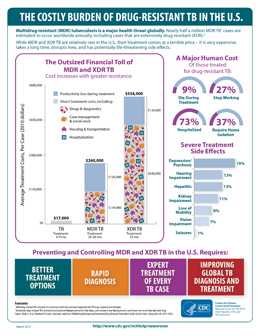
The Costly Burden of Drug-Resistant TB in the United States
View High Resolution Version
Multidrug-resistant (MDR) tuberculosis is a major health threat globally. Nearly half a million MDR TB cases are estimated to occur worldwide annually, including cases that are extensively drug-resistant (XDR).
This infographic highlights that while MDR and XDR TB are relatively rare in the U.S., their treatment comes at a terrible price – it is very expensive, takes a long time to treat, disrupts lives, and has potentially life-threatening side effects.
Embeddable Infographics

Copy the code below to embed this image (800×1035)

Copy the code below to embed this image (620×802)
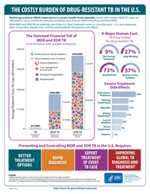
Copy the code below to embed this image (150×194)
Infographic Components
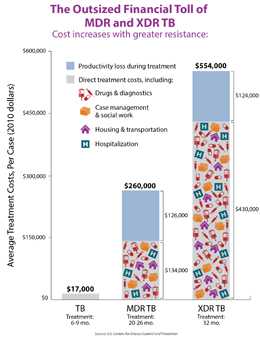
The Outsized Financial Toll of MDR and XDR TB
View High Resolution Version
The average cost of treating each TB case increases with greater resistance. Average direct cost ranges from $17,000 to treat drug-susceptible TB to $430,000 to treat the most drug-resistant form of the disease (XDR TB). When including productivity losses experienced by patients while undergoing treatment, costs are even higher.
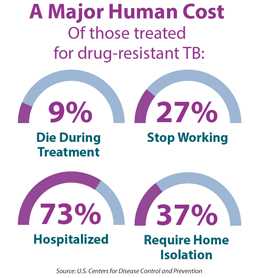
A Major Human Cost
View High Resolution Version
In addition to the economic toll, treatment for drug-resistant TB comes at a major cost to patients’ quality-of-life. Of those treated for drug-resistant TB 9% died during treatment; 27% stopped working; 73% were hospitalized; and 37% required home isolation.
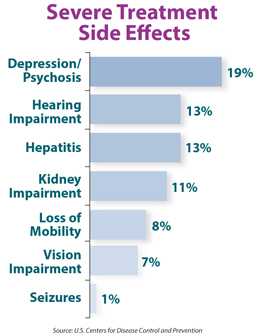
Severe Treatment Side Effects
View High Resolution Version
Substantial proportion of patients treated for drug-resistant TB experience serious side effects, including: depression/psychosis, hearing loss, hepatitis, and kidney impairment, among others.
Graphics: Key 2013 National TB Surveillance Data
The graphics highlight major findings from CDC’s analysis of 2013 national surveillance data. Click an image below to see and download a high-resolution version. These images are in the public domain and are thus free of any copyright restrictions. As a matter of courtesy, we ask that the content provider be credited and notified of any public or private usage of an image.
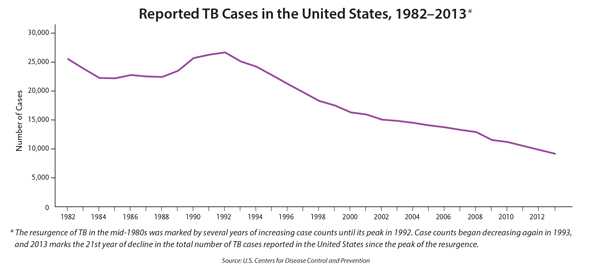
Reported TB Cases in the United States, 1982-2013
View High Resolution Version
The resurgence of TB in the mid-1980s was marked by several years of increasing case counts until its peak in 1992. Case counts began decreasing again in 1993, and 2013 marks the 21st year of decline in the total number of TB cases reported in the United States since the peak of the resurgence.
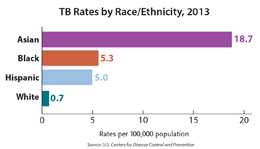
TB Rates by Race/Ethnicity, 2013
View High Resolution Version
Although TB rates declined among all racial/ethnic groups, TB rates among racial/ethnic minorities are much higher than those of whites. Rates for Asians (18.7/100,000), blacks (5.3), and Hispanics (5.0) were 26, seven, and seven times higher than among whites (0.7), respectively.
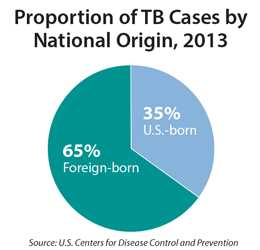
Proportion of TB Cases by National Origin, 2013
View High Resolution Version
Despite declines in the rates of TB among both foreign- and U.S.-born individuals, the TB rate among foreign-born persons was 13 times higher than among U.S.-born persons.
Quotes: CDC Experts on New TB Studies
Below are quotes for attribution to Dr. Jonathan Mermin and Dr. Philip LoBue to assist with your coverage of CDC’s new data for TB in the United States.
Dr. Jonathan Mermin, Director, National Center for HIV/AIDS, Viral Hepatitis, STD, and TB Prevention (on the importance of TB prevention)
“We have made substantial progress toward TB elimination in this country, but TB remains a formidable opponent with thousands of cases still diagnosed each year. TB can be fatal and treatment remains long and difficult. This ancient bacterium has demonstrated its ability to evade our attacks many times before.”
“TB can happen anywhere, in any community. Exposures can happen at school, at work, at home, while traveling, or anywhere that people are in close contact with one another. This is why TB prevention is a public health priority for the nation.”
“Too many falsely believe TB is a disease of the past, but to truly relegate this disease to the pages of our history books, we must identify better ways to detect and treat TB and we must stop the emergence of further drug resistance.”
Dr. Philip LoBue, Acting Director, Division of Tuberculosis Elimination (on the severe human and economic costs of drug-resistant TB)
“This study demonstrates the severe human and economic costs of treating drug-resistant TB. Even though we can typically cure these cases through complex care, this success comes at a price—for those who suffer and for the millions of dollars it costs the U.S. healthcare system.”
“The extremely high toll on the quality of life for patients is no less tragic. Many of those being treated for drug-resistant TB must endure severe side effects such as hearing loss, depression, or even psychosis. Patients also face home or hospital isolation.”
“In a shrinking world where diseases know no boundaries, the severe global TB epidemic poses a direct threat to the United States. The worldwide emergence of extensively drug-resistant TB is creating limited treatment options and in a worse-case scenario could lead to virtually untreatable TB strains.”
###
- Page last reviewed: March 24, 2014
- Page last updated: March 24, 2014
- Content source:


 ShareCompartir
ShareCompartir

